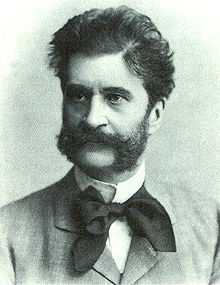Ritter Pázmán
| Johann Strauss II |
|---|
 |
|
Operettas and operas
See also: |
Ritter Pázmán (Knight Pazman) is the name of a three-act opera composed by Johann Strauss II, with the libretto by Ludwig Dóczi. It first premiered at the Hofoper in Vienna on New Year's Day in 1892.[1][2] It is based on a Hungarian narrative poem, Pázmán lovag, written by the Hungarian poet János Arany,[3] and takes about three hours to play its course.
Roles
| Role | Voice type | Premiere Cast, 1 January 1892 (Conductor: Johann Strauss II) |
|---|---|---|
| Pázmán | bass | Franz von Reichenberg |
| Eva | mezzo-soprano | Marie Renard |
| Gundy | contralto | |
| Karl Robert of Anjou | tenor | |
| Mischu | tenor | |
| Omodé | tenor | |
| Rodomonte | baritone | |
| The queen | soprano | |
Synopsis
- Place: Hungary
- Time: the Renaissance
Acts 1 and 2
Pázmán's castle
The knight's wife and servants are hurrying to prepare a meal to welcome Pázmán and his band on their way back from the hunt. One of the hunters falls in love with the knight's wife, and kisses her on the forehead when the husband is not looking. Later, after the hunter leaves, Pázmán finds out about the kiss, and, having cursed his wife, goes to the king to demand justice.[4]
Act 3
The King's castle
The knight was followed by his wife and maid. He insists that he be allowed to kiss the hunter's wife as revenge. The king then says that he was the one who kissed Pázmán's wife. Pázmán is then allowed to take a kiss from the queen.[4]
Public reception
When the opera's debut was announced, it was met with great enthusiasm, as was the case with most of Strauss' works, and it attracted special attention because it was Strauss' first (and only) opera. However, at its premiere, it was received coldly, and most critics predicted that it would not last long at the opera house.[4] The Vienna Opera played it only nine times. Critics complained about the banality of the opera's text, and a reviewer for the Wiener Abendpost commented that the characters were not distinguished enough musically.[4] Others said that the opera died of "acute text failure".[5] Some critics, however, such as Richard Heuberger, noted that the instrumentation of the opera was commendable, especially Strauss' use of the dulcimer in the csárdás.[4]
References
- Notes
- ↑ Operetta: A Theatrical History. Pennsylvania State University Press. 2003. p. 130.
- ↑ Greene's biographical encyclopedia of composers. Reproducing Piano Roll Fnd. 1985. p. 675.
- ↑ The waltz emperors. Putnam. 1973. p. 250.
- ↑ 4.0 4.1 4.2 4.3 4.4 Johann Strauss and Vienna. Cambridge University Press. 2006. p. 362.
- ↑ American history and encyclopedia of music. Squire Cooley. 1910. p. 362.
- Sources
| ||||||||||||||||||||||||||